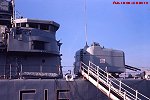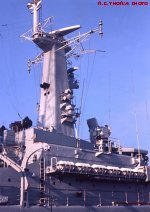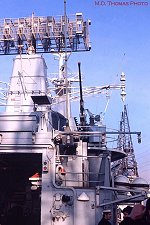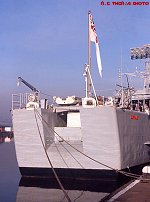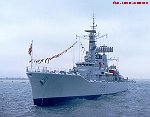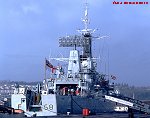|
LEANDER Class
General-purpose Frigates (as built)
|
![]()
|
The Leander class was the UK’s most successful frigate design.
This design combined operational flexibility with excellent sea-keeping
in affordable ships that were adaptable to new requirements. Leander
s were very active with Royal Navy aircraft carrier task forces and
in other operations. This section covers the RN ships as built. A separate
section covers these ships as modernized.
In the late 1950s the naval construction directorate added air conditioning
and a helicopter facility to a Rothesay (Type 12) design intended
for New Zealand. Features brought forward from the Type 12 design included
the hull shape, the engineering plant, and part of the armament. Elimination
of deck-mounted tubes for the canceled Mk 20E heavy torpedo permitted
a larger superstructure while still leaving paths on deck for underway
replenishment. In a new seawater-compensating fuel system, fuel tanks
once emptied of black oil could be refilled with seawater to maintain proper
trim. This eliminated the Type 12's separate water-ballast trim tanks
and permitted the relocation of heavy equipment in their stead low in
the ship. Both diesel electrical generators were relocated from the forecastle
to a lower location forward of the boiler room. Their exhaust vented through
ducts in the foremast, which was stepped further forward than in the Type
12.
With the resulting increased stability margin and the additional
internal space, the designers added a large operations center, the helicopter
facility, variable-depth sonar (VDS), a long-range air-search radar,
more-capable communications, a centralized cafeteria, active stabilizer
fins, and provision for Sea Cat missiles for close-range air defense.
The Admiralty, greatly liking this design, ordered conversion to
it of an authorized Type 61 frigate and of three Type 12 frigates on
the building ways. These became the first four Leanders. The
Leander class never had a frigate type number, in particular not
“Type 12M.” Type-numbering of new designs was functionally irrelevant after
the RN abandoned the mobilization strategy in 1954.
During the 10-year construction program the installed armament varied,
as the tables show. The Canadian-developed combination of variable-depth
sonar and a ship-based helicopter was intended to equalize the fight
against fast submarines. With VDS, the helicopter, and the improved operations
room, Leanders could engage submarines at longer range,
which improved the probability for detecting submarines and gave more
time to engage. Seven of the first 10 ships mounted imported Canadian
SQS-504 VDS as Sonar Type 199 and four later ships mounted British-built
licensed copies. Other ships carried the hoisting gear for the VDS but
never received transducers.
The first ten ships retained the Y-100 steam propulsion plant of
the Type 12 and Type 14 frigates. The next six, Phoebe through
Danae , had a Y-136 improved propulsion plant. The final
ten ships mounted the same armament as the preceding ships but featured
a Y-160 automated propulsion plant and a wider hull for modernization.
The RN built 26 Leanders and other navies built 18. This total
of 44 set the post-1945 record for construction to one design among frigates
and larger warships outside the United States and Russia. Elaborate
“finish” was arguably wasteful but perhaps good appearance contributed
to foreign naval orders for Leanders. Exclusive of weapons, in
the mid-1960s construction cost about the same per ton as for the contemporary
USN Knox-class (DE/FF 1052) frigates. The Leander
program reportedly bolstered American political enthusiasm in the 1960s
and 1970s for frigates, although the U.S. Navy designs had no technical
connection with the British ships. Newer warships derived from the
Leander design have included HMS Bristol, the RN Type 22 frigates,
and the Indian Godaviri and Bramhaputra classes.
The Leander design introduced little new technology: no gas
turbines, long-range missiles, computers, or automatic guns. If this
cautious choice was a gamble, the RN won the bet because these technologies
proved largely experimental until about 1970. The RN then began to induct
the Leander s for mid-life modernization. The first three
Leanders to be modernized were withdrawn from service during
1970–71 even while the final four of the class were being built largely
to the then-obsolescent original design.
High inflation during the 1970s greatly increased the
financial cost of mid-life modernization. The 1981 defence review halted
additional major conversions. That left the final five Leander
s with their obsolescent as-built armament for the remainders of their
RN careers. |
||||||||||||||||||||||||||||||||||||||||||||||||||||||||||||||||||||||||||||||||||||||||||||||||||||||||||||||||||||||||||||||||||||||||||||||||||||||||||
|
LEANDER Class |
||||||||||||||||||||||||||||||||||||||||||||||||||||||||||||||||||||||||||||||||||||||||||||||||||||||||||||||||||||||||||||||||||||||||||||||||||||||||||
|
Specifications
Displacement:
2,930 tons full load
Propulsion:
2 550 PSI boilers, 30,000 SHP (22.5 MW), 2 shafts, 28 knots
Hanger and deck for 1 Wasp HAS Mk 1 helicopter (retired March 1988).
Surveillance and Surface Action
Search radar: Type 965 long-range air search, Type 993 surface search,
Type 978 piloting.
Note: All air-defense weapons could also fire in surface action.
The Type 965 air-search radar, a major advance over the Type 12 design,
was jocularly called 'the key,' as in a clockwork-driven toy.
First 7
: 2 4.5" guns (Mk 6 mount), Medium-Range System Mk 3 director (MRS
Mk 3; radar Type 903). 2 40mm Mk 9 guns.
Others
: 1 Sea Cat SAM, GWS22 director (radar Type 904; except Naiad
had manual GWS20 only). 2 4.5" guns (Mk 6 mount), MRS Mk 3. 2 20mm
guns.
Note
: The Leanders were far in advance of others navies, including
the USN, in mounting guided missiles for point defense.
First 22
: 1 Mk 10 mortar. Sonar: Type 177 scanning sonar; Type 199 VDS on
11; Type 170 attack sonar; Type 162 sea floor tracing sonar. Decoy:
Type 182.
Last 4
: 1 Mk 10 mortar. Sonar: Type 184M multi-function (active scanning,
torpedo warning, Doppler); Type 170; Type 162. Decoy: Type 182.
First group (4)
:
Second group (15)
:
Third group (7)
:
Photos: (click on thumbnail for bigger image) |
||||||||||||||||||||||||||||||||||||||||||||||||||||||||||||||||||||||||||||||||||||||||||||||||||||||||||||||||||||||||||||||||||||||||||||||||||||||||||
![]()


